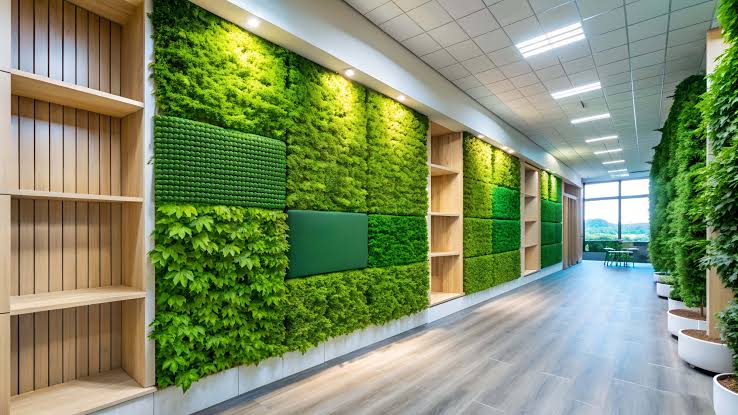Green acoustics focuses on developing acoustic wall products and systems that are environmentally sustainable while still providing effective sound absorption and noise reduction.
With rising awareness of the environmental impact of construction materials and increasing demand for healthy indoor spaces, there is a growing need for eco-friendly acoustics solutions. This article explores some of the sustainable materials and techniques that can be utilized to create green acoustic walls.
Recycled Materials
Using recycled materials drastically reduces the ecological impact of manufacturing acoustic wall materials. Recycled denim, cotton, and PET from plastic bottles can be cleaned, shredded and compressed into acoustic wall panels. The reused cotton, jeans, and polyester fibrous padding absorb sound waves propagating through the air.
Their random fiber arrangement and density gradient contribute to sound dampening. Additional sustainability can be achieved by using zero-VOC adhesives and water-based binders during the panel fabrication process. Recycled paper/cardboard and acoustic foam products are also available for absorbing sound.
Renewable Plant-Based Materials
Several renewable resources from fast-growing plants represent an eco-friendly option. Straw-wool made from leftover wheat and rice straws arranged randomly in mats provides reasonable sound absorption. The hollow straws diffract sound waves propagating through them. Bamboo is highly renewable, biodegradable, and has a rapid growth rate.
InsulationPoint noted that bamboo acoustic wall panels feature good sound absorption qualities and have aesthetic visual appeal. Bamboo can be split into fibers and pressed into boards or woven into noise diffusing panels. Pressed coconut coir pads also demonstrate acoustic properties on par with rock wool and fiberglass. Using no chemicals during extraction results in very low embodied energy. Organic starches and glues derived from plants keep these products sustainable through their life cycle.
Bio-Based Composite Boards
Several eco-friendly acoustic wall boards utilize a bio-based composite structure. These often combine agricultural crop residues like soy stalks, corn stalks, bagasse, or rice husks with a formaldehyde-free glue resin to create a rigid, porous board with good acoustic performance. The composite production process generally uses steam injection pressing to conform the loose, random fibers into a stable board in various thicknesses.
No chemical treatments are employed, allowing the composite boards to be recycled or naturally composted if landfilled. Their high recycled material content and minimal processing energy requirements give these bio-composites excellent sustainability metrics.
Fabric Wrapped Panels
An eco-friendly option for improving wall acoustics is to wrap sustainably sourced panels in fabric. Organic cotton, wool, hemp, or linen fabrics can envelop rigid backing materials like cork boards, strawboard, or bamboo panels intended for walls or ceiling installation. The air gaps behind the fabric allow it to act as an absorber and diffuser while adding an extra design flair. Sound waves permeate but lose intensity through the porous fabric layer.
Minimal-impact dyes can color the material aesthetic while being benign to humans and the environment during manufacturing or use. Fabric wrapped panels dampen sound naturally without employing harmful chemicals commonly used in synthetic polymeric acoustical products. They are gaining more popularity among acoustic wall products.
Phase Change Materials
Some novel green acoustic materials incorporate phase change elements to absorb sound. Bio-based phase change materials derived from fatty acids passively modulate temperature and latent heat. By absorbing and releasing heat they create air cavities and perturbations in the material surface in the presence of sound waves.
As acoustic waves propagate through these dynamic physical changes, their movement is disrupted, converting sound energy to small thermal fluctuations without added energy input. Myriad micro-structural alterations emerging from the phase transition dissipate vibration and sound propagation. Integrating fatty acid-based phase change elements into wall panels enables sustainable passive noise control.
Sustainable Acoustic Plaster & Finishes
Applying eco-friendly plaster or finishes to walls can contribute acoustic properties to rooms. Clay plasters mixed from natural clays, sand, plant fibers, and proteins harden into an absorbent, vapor permeable layer once dry. Fermentation of the biological components creates microscopic pores that diffuse resonant sound waves. Adding chopped hemp, sisal, or wool introduces further porous fibrous materials. Clay plasters evenly spread over walls improve sound absorption across entire surfaces, especially at higher frequencies.
Sustainable lime-based finishes also demonstrate acoustic potential. Hydraulic lime plaster binds sand particles creating a rigid, cellular structure ideal for sound dissipation. The plaster surface can be finished with limewash using slaked lime, water, natural pigments and vegetable additives. Limewash dries to a matte, permeable calcite crystalline coating that scatters sound waves propagating horizontally along the wall.
Silica microspheres may also supplement lime finishes to diffract sound at targeted frequencies. Clay and lime acoustic plaster systems avoid synthetic chemicals while improving room acoustics through renewable geological and plant derivatives.
Non-toxic Natural Paints & Varnishes
Coating walls with plant-based paints or oils can improve acoustic performance sustainably. Natural paints feature bulking agents like talc, mica, clay, casein, starch, cellulose, soy, and some volatile organic compounds as solvent carriers for pigments. Noise reduction coefficients comparative to synthetic paints mean plant-derived options can moderate sound levels. Linseed, tung, and citrus oils applied to wood paneling protect surfaces from abrasion and supply durable acoustic enhancement.
Natural paint ingredients such as beeswax, tree and plant resins, linseed and citrus oils help seal porous materials commonly used for wall panels, blocking sound leakage and echoes. Eco-friendly milk, mineral, and citrus-based paint strippers help rejuvenate old painted walls to renew their acoustic functionality.
While biodegrading, loose paint flakes and peels act as additional fine diffusers aiding reverberation control. Non-electric sanding prepares the surface for reapplication of natural acoustic paints whenever needed. Utilizing plant-sourced wall coatings avoids introducing harmful volatile organic compounds while facilitating sound absorption through renewable materials and minerals.
Final Words
Implementing green materials and techniques allows acoustic wall products to effectively absorb sound while upholding ecological stewardship goals. Eco-conscious options like agricultural fibers, recycled content, renewable plant materials, bio-composites, and phase change integration offer excellent noise reduction without toxic chemicals or unsustainable resource extraction. Creative use of reusable, biodegradable, and emission-free alternatives minimizes environmental impact while enabling healthy and productive built environments. Green acoustics aligns environmental ethics with practical product functionality for interiors.















